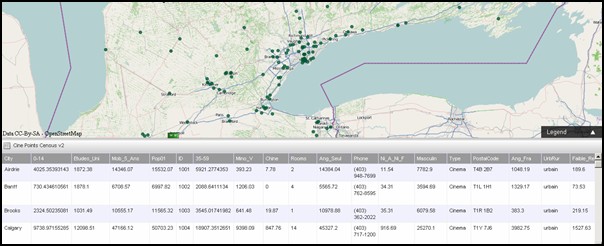cinematographic atlas
Canadian Movie Theaters Sociodemographic profiles (2006 Census)
The creation of the service areas database is based on the Canadian Movie Theaters Spatial Distribution. The geolocation of the theaters was the first necessary step before trying to build their socio-demographic profile.
Service areas for all Canadian theaters were generated from the Canadian road network (CanMap RouteLogistics, DMTI Spatial, 2001) and the module ArcGIS Network Analyst 9.2. A service area is the area formed by the distance covered in 5 minutes (10 minutes in rural areas) from a cinema. This distance of 5 minutes corresponds to a car ride at the maximum allowed speed, under optimum conditions (no traffic lights, no traffic jam, etc..). Once produced, these service areas were used to aggregate socio-demographic data from the census at the subdivisions level (Statistics Canada 2001). The values for each census subdivision (eg, population, average age, etc..) have been aggregated by service area as a function of the area represented by each census subdivision within each service area. In other words, a service area covering 50% of a census subdivision was allocated 50% of socio-demographic effectives from this census subdivision. This method can estimate the socio-demographic characteristics of neighborhoods in which each theater draws much of its audience. Each film has therefore been assigned a socio-demographic profile defined in terms of its service area.
For a deeper analysis of the movie theaters' spatial distribution, we suggest this article (French only):
Caquard S., Naud D., and Perichon V. 2009. "La répartition des salles obscures canadiennes: un éclairage géographique", Cahiers de géographie du Québec 53 (149): 221-241.
In the spirit of the Creative commons, data collected and created in the context of this project are available to visitors and researchers, provided that three conditions are met:
- Attribution: You must attribute the work in the manner specified by the author or licensor (but not in any way that suggests that they endorse you or your use of the work).
- Noncommercial : You may not use this work for commercial purposes.
- Share Alike: If you alter, transform, or build upon this work, you may distribute the resulting work only under the same or similar license to this one.

